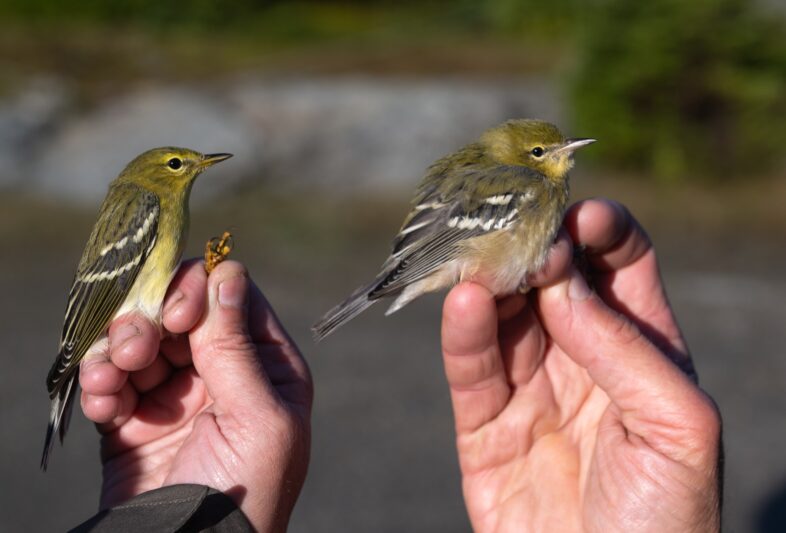
Quintessential “confusing” fall warblers: Blackpoll (left) and Bay-breasted (right). Mt. Mansfield, 21 September 2023. © Charles Gangas
It’s impossible to keep VCE biologists away from Mt. Mansfield’s ridgeline. We’ve been drawn there annually—some might say obsessively—for the past 32 years. Long after Bicknell’s Thrushes (BITH) and Blackpoll Warblers have fledged their young and completed post-breeding molt, VCE returns for an annual early autumn pilgrimage. Part recreation, part wrap-up of our summer field season, we can bank on BITH still being present and, usually, a strong showing of passage migrants in our mist nets. As always, our fortunes hinge on weather, as last September’s soggy finale so emphatically underscored.
After one of Vermont’s wettest summers on record, with more weekly field cancellations and postponements than any of us can remember, we nervously monitored the mountain forecast prior to our two-night outing, planned for 18-20 September. With a cast of characters including VCE staff and board, plus several friends and colleagues, we could ill afford poor weather that would derail schedules. Inevitably, however, as 9/18 approached, the forecast deteriorated, and we reluctantly pushed back 24 hours—a wise decision, in retrospect, as strong winds and rains lashed the ridgeline throughout what would have been our first night, and the following day.
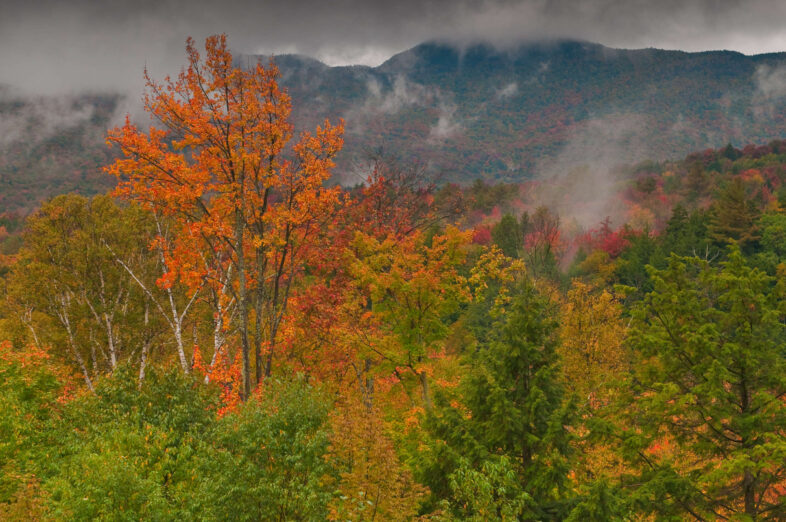
Mansfield’s ridgeline bathed by rain-laden clouds, which forced a 24-hour postponement of VCE’s 2023 wrap-up banding session. © Charles Gangas
Taking our meteorological chances, a small VCE crew headed up the toll road in late afternoon on the 19th, fully aware that rains and wind would persist until midnight, when a cold front promised clearing skies and NW winds. We sat impatiently in the Octagon ski patrol hut until ~6 pm, then decided to brave the elements and ascend to the ridgeline to set nets. As rivulets of rainwater gushed down the trails, our chilly hands—but dry feet, in rubber boots—managed to erect 25 nets, leaving them furled, by the time dusk fell. Despite weather conditions, several hardy BITH announced their presence with calls and a few snatches of song.
The following morning, nets were open for business when dawn broke at 6 am (a leisurely schedule for ornithologists by June and July standards). Clouds continued to scud across the ridgeline, and temperatures held in the mid-40s F. Captures began as a trickle, but increased as clouds lifted and the air warmed. Skies had cleared completely by afternoon, treating us to a chilly evening, a star-stuuded night, and a crisp morning on 9/21. Spirits were high, as our ranks swelled with the arrival of additional staff and associates to help close out VCE’s 2023 banding season.
As expected during fall migration, our 183 captures over two days of banding were heavily weighted towards first-year (HY, or hatching-year) birds. Diversity was solid, if not spectacular, with 19 species, though no eyebrow-raisers. Highlights included our second-ever Western Palm Warbler, single Tennessee, Nashville and Bay-breasted warblers, and a Brown Creeper. We were all surprised not to capture even one Swainson’s Thrush.
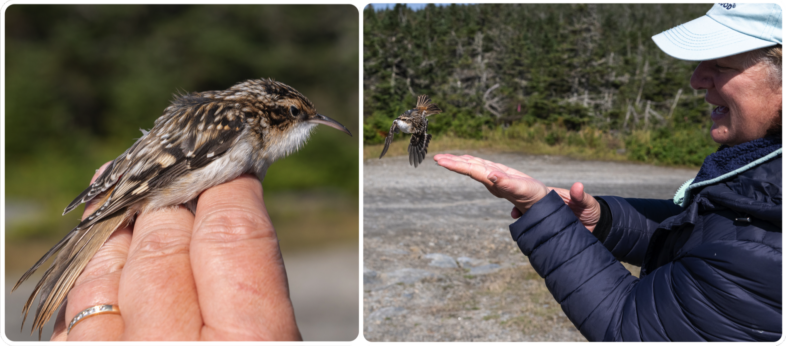
Always a crowd pleaser, this Brown Creeper turned up in VCE’s nets, either as a locally dispersing bird from nearby lower elevation hardwoods or a passage migrant. Susan Hindinger was its lucky releaser after banding. © Charles Gangas
Red-eyed Vireo — 6 new bandings of HY birds
Blue Jay — 1
Ruby-crowned Kinglet — 36
Golden-crowned Kinglet — 10
Brown Creeper — 1
Winter Wren — 1
Bicknell’s Thrush — 20: 12 new bandings, 2 returns of 2022 birds (first 2023 captures of both), 6 within-season recaptures of adult males
Hermit Thrush — 3: 1 HY, 2 adults (1 in heavy flight feather molt)
American Robin — 1 HY
Purple Finch — 1 HY
Dark-eyed Junco (Slate-colored) 37 (all but 2 HYs)
White-throated Sparrow — 8, including 1 retrapped adult in heavy flight feather molt
Tennessee Warbler — 1 HY
Nashville Warbler — 1
Bay-breasted Warbler — 1 HY
Blackpoll Warbler — 12: 11 new bandings; 1 return of a female banded on 18 Sep 20, recaptured in both 2021 and 2022, but not until today in 2023 with a high fat load and weighing 19 g (8-9 g more than typical breeding weight)
Palm Warbler (Western) — 1 HY, only VCE’s second-ever
Black-throated Blue Warbler — 4 HY birds (2 males, 2 females)
Yellow-rumped Warbler (Myrtle) — 37 new bandings
Perhaps our most noteworthy capture was a plump female Blackpoll Warbler (band #2540-59744), who merits special recognition. A decade ago, VCE’s research with light-level geolocators showed that this long-distance migrant undergoes an epic non-stop, transoceanic flight each autumn to wintering grounds in northern South America. To fuel this audaciously risky trek of 1,500-2,000 miles, Blackpolls forage voraciously and deposit layers of fat beneath their skin prior to departing—some birds double their weight before launching southward. Many birds move to coastal “staging” sites to bulk up, and fat Blackpolls are seldom documented at inland sites like Mansfield. Female 2540-59744 proved a notable exception; she weighed in at 19 grams on 21 September, a full 8-9 g over typical breeding weight. Moreover, she is a bird well known to VCE: we first banded her on 18 September 2020 as an adult bird of unknown sex (we can’t reliably determine sex of Blackpolls in non-breeding plumage). She then returned the following two summers as a local breeder, with first recaptures in 2021 on 2 June and in 2022 on 31 May. This year she somehow eluded our array of mist nets until her capture on 9/21. We’ll never know whether 2540-59744 continued on to the New England coast or struck out directly from Mansfield for her monumental southward voyage, but we can all marvel that she has accomplished this perilous odyssey no fewer than four times previously!
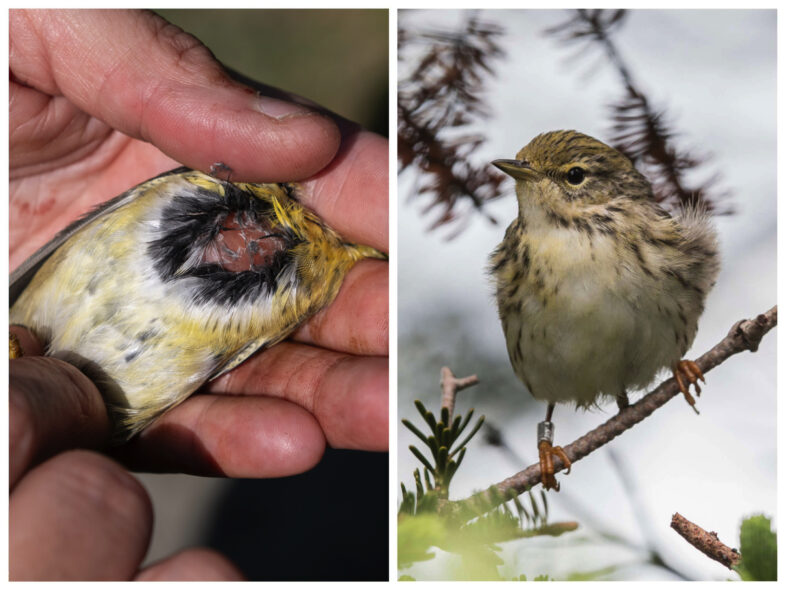
Left: Blackpoll Warbler female #2540-59744 on 21 September 2023, showing a heavy load of subcutaneous fat that will fuel her intrepid transoceanic flight from New England to northern South America; right: an adult female Blackpoll Warbler (though almost certainly not #2540-597440) in breeding plumage on Mt. Mansfield. © Charles Gangas
Apart from ubiquitous Yellow-rumped Warblers and kinglets—though our 36 kinglet captures were a far cry from September 2021’s veritable storm of 101 Ruby- and Golden-crowneds—BITH carried the day numerically, as they invariably do in mid-September. Admittedly, we were disappointed not to recover another GPS backpack from one of the 20 BITH tagged last summer (we did retrieve 10 in June and July, so no complaints there), we fitted an additional 5 birds with miniature nanotags, bringing our season total of nanotagged birds to 28. We shifted our focus this year from older males (the demographic cohort we have studied most intensively) to females, yearling males, and juvenile or hatching-year birds. As these birds wing their way south to Hispaniola, Cuba, Jamaica, or Puerto Rico this fall and back again next spring, Motus towers arrayed across the landscape will track their movements, yielding remarkable insights on the species’ little-known migratory patterns, and conservation needs.
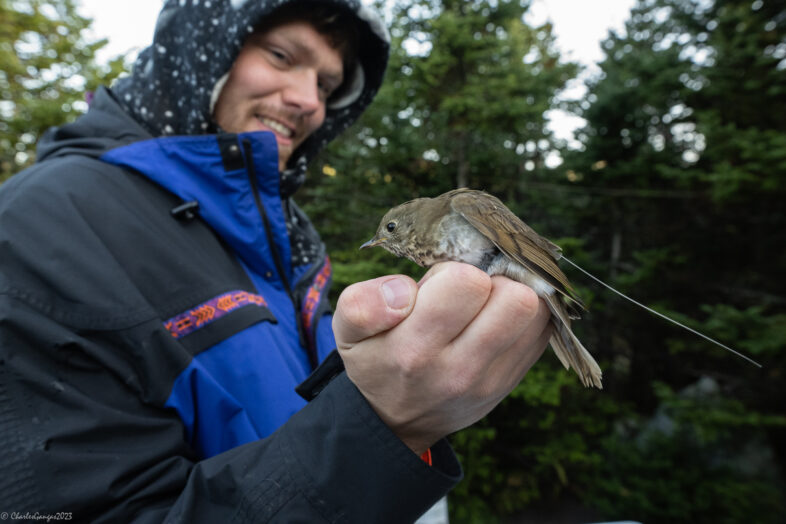
Kevin Tolan with a nanotagged Bicknell’s Thrush, ready for release. Via an extensive network of Motus receiving stations along the East coast, VCE hopes to gain new insights on the migratory patterns of this and 27 other Mansfield-tagged BITH during the next year. © Charles Gangas
Finally, this visit marked the end of an era for one crusty ornithologist who launched VCE’s Mansfield studies in 1992. Leading that work has been the privilege and joy of a lifetime for yours truly. I have never tired of endlessly intriguing conservation science questions, the thrills of new discoveries, breathtaking sunrises and sunsets, the anticipation inherent in each net run, stunning views, being witness to seasonal and annual rhythms, and, yes, the formidable challenges of studying montane forest birds. Sleep has often been short, weather harsh, black flies bloodthirsty, terrain punishing, fir thickets impenetrable, birds uncooperative. Yet, I’ve kept coming back, week after week, year after year. The rewards of working on Mansfield have captivated and inspired me. Foremost among those have been my rich associations with people. From fellow VCE staff to seasonal interns, scientific colleagues to fellow birders, VCE board members to loyal donors, school groups to Audubon societies, I have relished every interaction. How many of us can hang up our hats feeling as fortunate as I do to have loved our work and gained so much in return? My transition does not in any way signal a diminution in VCE’s commitment to Mansfield—on the contrary, VCE’s next 32 years promise innovative advances, ever exciting scientific revelations, and a new generation of passionate conservation ecologists. I’m eager to see it all unfold, and I may even make an occasional cameo appearance on the ridgeline. Old habits die hard…
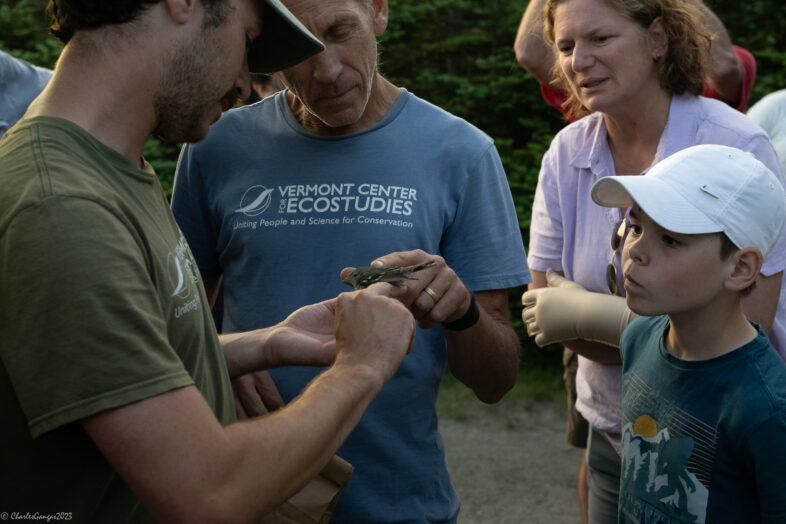
2023 marked the passing of a VCE torch on Mansfield, extending across generations. Nathaniel Sharp and Chris Rimmer examine a female Blackpoll Warbler, while VCE Executive Director Susan Hindinger and possible future BITHnologist Greyson Hunt look on. © Charles Gangas
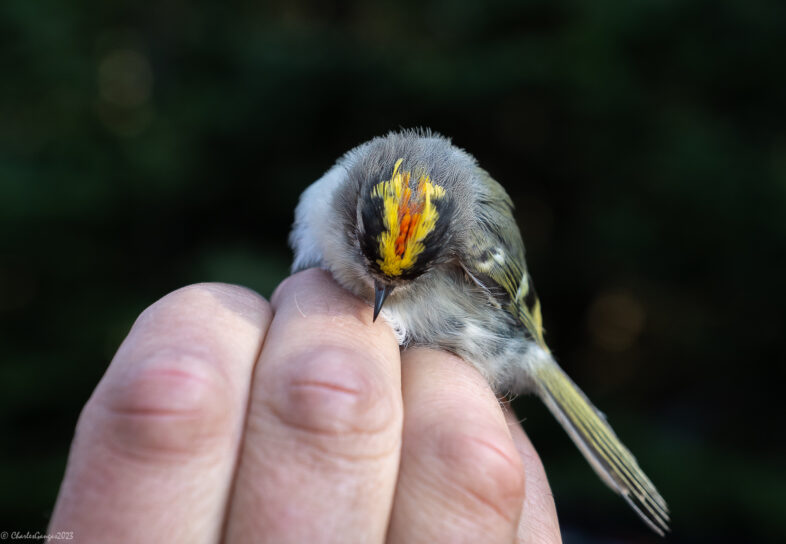

perhaps of interes Rain o rain…
Chris, you’ve had a truly amazing run on Mansfield. Thanks so much for all of your contributions to conservation. The Bicknells are lucky to have had you on their side! All your work will not be forgotten and you can feel good knowing that you’ve set in motion a very good thing indeed. Cheers!
Wonderful article, Chris! Those birds are so lucky to have had you, and I hope that means you’ll have more time to visit/band with your friends at CT Audubon Birdcraft Museum and Sanctuary!! We’ve missed your visits!
XJudy
I can hardly believe Mt. Mansfield without you Chris.
Thanks for your tireless work there and for your informative reports.
One of my birding highlights was spending the overnight with the crew and releasing a Bicks! Thanks for a great memory.
Thank you so much. I have thoroughly enjoyed reading your postings over the years.
Sad re this retirement moment, but readers of your reports over the years are happily in your debt, Chris. Your work has turned so many of us English majors into citizen helpers of science, and supporters of VCE’s goals. Thank you for everything!
I have long admired your posts for their scientific accuracy and importance. But it is the the passion, wonder and awe that you convey in them that keeps me reading. Thank you for your service to the natural world and all of its inhabitants, including me!
Thank you, Chris, for all your years of work and dedication to the Mt. Mansfield studies for so many years. I always enjoy your reports and fondly remember the overnight banding experience one June with New Mexico friends.
It was a pleasure to visit Mansfield with you Chris. Firsthand I experienced your boundless enthusiasm and unmitigated joy at documenting the Bicknell’s Thrush and other avian activity in that st times harsh but always breathtaking locale. Thanks for your hard work.